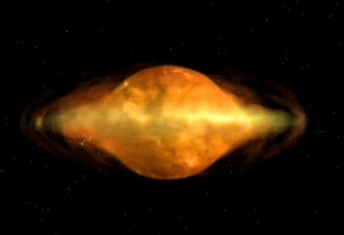|

In Star Trek, a Graviton Ellipse was a stable pocket of
normal space moved by a surrounding elliptical concentration of
graviton particles, called gravimetric distortions. The graviton is an
elementary particle that transmits the force of gravity. It is used for
a variety of purposes involving attractive/repellent forces, such as
tractor beams, the gravity plating on starships or antigravs. The
opposite of a graviton is an antigraviton.
Graviton ellipses traveled through subspace. Emerging
into normal space and extra-dimensional realms only when they were in
proximity of objects that emited electromagnetic energy, such as
spacecraft and dark matter asteroids. The ellipses themselves generated
an electromagnetic radiation field, of dangerous levels to humanoids,
that made the anomaly react like a magnet drawn to another magnet,
relative to it's target.
One such graviton ellipse, with a perimeter over a
kilometer in diameter, had been in existence from the time of the
formation of the Milky Way Galaxy. It was found to have devoured
objects from all of the quadrants of the galaxy. In 2032 this anomaly
emerged in the Sol System and devoured the Ares IV Mars orbiter. This
was mankinds first encounter with a spatial anomaly. The same ellipse
attempted to devour USS Voyager, in 2376, in the Delta Quadrant.
Commander Chakotay suggested the anomaly to be renamed as the "kitchen
sink anomaly" due to the debris field contained inside. Graviton
ellipses have been observed only a handful of times, and no known ship
has ever survived the encounter or escaped being devoured, before the
Voyager. (VOY: "One Small Step")
In actual physics, the graviton is indeed a hypothetical
elementary particle that mediates the force of gravity in the framework
of quantum field theory. Gravitons are postulated because of the great
success of the quantum field theory (in particular, the Standard Model)
at modeling the behavior of all other forces of nature with similar
particles: electromagnetism with the photon, the strong interaction
with the gluons, and the weak interaction with the W and Z bosons. In
this framework, the gravitational interaction is mediated by gravitons,
instead of being described in terms of curved spacetime as in general
relativity. In the classical limit, both approaches give identical
results, which are required to conform to Newton's law of gravitation.
String theory also predicts the existence of gravitons.
However, attempts to extend the Standard Model with
gravitons run into serious theoretical difficulties at high energies
(processes with energies close to or above the Planck scale) because of
infinities arising due to quantum effects. Some proposed theories of
quantum gravity (in particular, string theory) address this issue. In
string theory, gravitons (as well as the other particles) are states of
strings rather than point particles, and then the infinities do not
appear, while the low-energy behavior can still be approximated by a
quantum field theory of point particles. In that case, the description
in terms of gravitons serves as a low-energy effective theory.
Unambiguous detection of individual gravitons, though
not prohibited by any fundamental law, is impossible with any
physically reasonable detector. The reason is simply the extremely low
cross section for the interaction of gravitons with matter. For
example, a detector the mass of Jupiter with 100% efficiency, placed in
close orbit around a neutron star, would only be expected to observe
one graviton every 10 years, even under the most favorable conditions.
It would be impossible to discriminate these events from the background
of neutrinos, and it would be impossible to shield the neutrinos
without the shielding material collapsing into a black hole.
However, experiments to detect gravitational waves,
which may be viewed as coherent states of many gravitons, are already
underway. Although these experiments cannot detect individual
gravitons, they might provide information about certain properties of
the graviton. For example, if gravitational waves were observed to
propagate slower than the speed of light in a vacuum, that would imply
that the graviton has mass.
|
|
